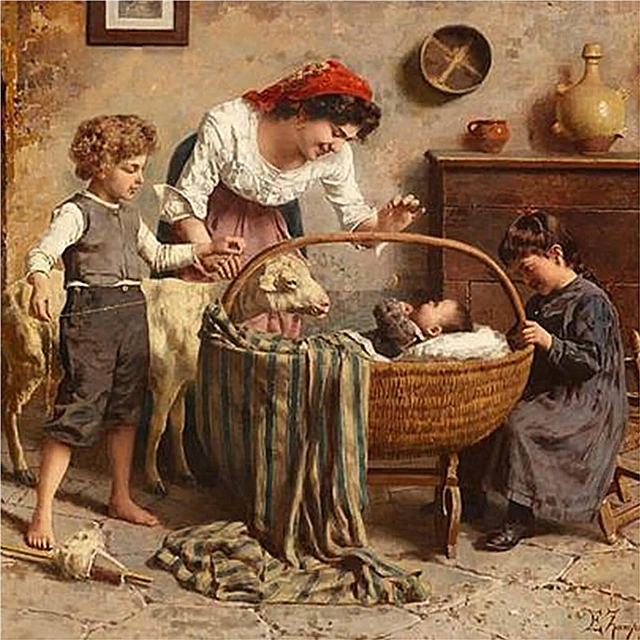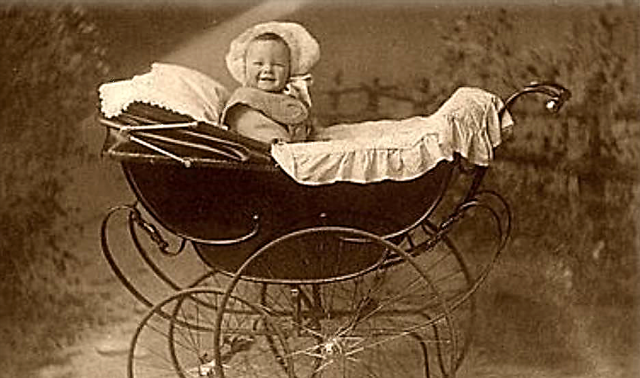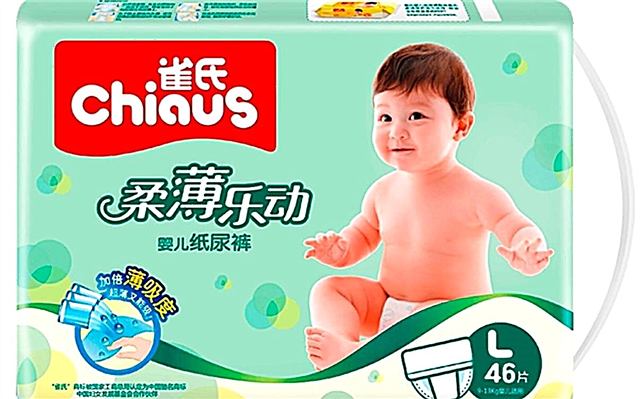Progress does not stand still and brings more and more new trends into our life. In the upbringing of children, over the next few years, everything has also changed dramatically, newfangled things have appeared that greatly facilitate the life of a young mother. Some of the recommendations and rules for caring for babies have passed the test of time and are still used today. And some of the advice that used to be considered the gold standard has become not only old-fashioned, but also dangerous for the health of babies.

Let me know: are you a girl or a boy?
At the end of the 19th century, when sewing clothes for young children, attention was paid not only to beauty, but also to practicality. For both girls and boys, spacious low-waisted dresses were sewn. This was due to the fact that the baby was perceived as an unformed and almost sexless creature and treated him like a gentle angel. The lack of panties was very comfortable. A child who had not yet been potty trained could relieve himself and not get dirty. At the time, fabric was expensive. Such tailoring made it possible to significantly save money, since the undershirts were enough for several years.
Boys, before entering the gymnasium, were brought up by female governesses and wore women's clothing. When it came time to enter an educational institution, trousers were sewn for them. At that time, the teachers in the gymnasiums were usually men. The dream of every little boy was getting rid of female guardianship, changing dress for trousers and moving into adult "male" life. In many families, celebrations were held in honor of the beginning of adolescent life for boys. In Western Europe, dresses for boys and girls differed in color and density of fabric. Boys wore brighter or darker shades, girls were dressed in low-key dresses, and the fabric was thinner.
Modern children are dressed very differently than before. One infant can have a complete wardrobe of clothing for every taste. Boys are no longer dressed in girlish dresses, but many girls do not crawl out of their panties.
In pre-revolutionary Russia, good upbringing and care was given only to children from aristocratic families. There, a nanny and a governess took care of the child, and the mother took care of herself.

There was no time to raise children in peasant families, they grew up by themselves. At best, they could be looked after by an older brother or sister, who themselves were barely five or six years old. Older children were already taken to work. Basically, the baby was wrapped in diapers and left alone in the cradle. So that the child could satisfy his hunger, a cow's horn, cut off at the end, was hung over his face. They put moistened sweetened bread in it, and the child could suck on it at any moment. So that by the evening the baby did not end up in a puddle of his own urine, a hole was cut in the bottom of the cradle, and the excess liquid drained onto the floor. Needless to say, in the absence of running water, washing children every day was an unattainable luxury.
Sterility comes first
In the 1920s, pregnant women and women in labor began to receive medical assistance and support. Women without children were considered flawed and were almost outcasts of society. Every Soviet girl aspired to get married and become a mother of at least two children. The well-known pediatrician G. N. Speransky and the doctor of medical sciences V. P. Lebedeva wrote the "Mother's Book" especially for young parents. Pregnancy and childcare were seen in her as nothing less than a civic duty to society. Newborns were treated like crystal vases, and when visiting the infant, doctors demanded surgical sterility and cleanliness. Before the war, nursing mothers wore a white dressing gown and a kerchief before latching a baby to their breast, and in case of a cold, a gauze bandage.
Paying tribute to the pediatricians of that time, it is worth noting that the hygiene of babies is not worse now than it was then. Modern industry has made life much easier for mothers and babies by producing a variety of baby care products. And the living conditions have improved significantly.
Swaddling a baby yesterday and today
Swaddling babies back in the days of Hippocrates. This tradition has survived to this day for a reason. In a newborn baby, the movements of the arms and legs are not yet coordinated, he does not know how to control his body. As a result, the crumb can scratch or hit itself. A sharp swing of the handle also scares the baby. A baby wrapped in diapers sleeps more calmly and the duration of sleep is much longer. In Soviet times, there was a myth that if you swaddled a child weakly, then he would have crooked legs. It is not true. On the contrary, tight swaddling is harmful to the child: the development of the musculoskeletal system slows down and the sense of touch worsens.

In the 80s, pediatricians decided that it was enough to swaddle only the lower part of the body along with the legs. To prevent the child from scratching himself, they cut his nails or put on special mittens. Child psychologists believe that freedom of action directly affects the inner world of the baby, making him self-confident.
Now only free swaddling is in use, and then it is recommended in rare cases, for example, if the baby has difficulty falling asleep. Now it is believed that freedom of action (in the literal sense of the word) is reflected in the inner world of the child: he grows more confident in himself. In addition, baby's skin breathes better without diapers, which is a good prevention of diaper rash.
New book publisher
What modern mother does not know the book of the famous American pediatrician B. Spock "A child and his care"? This edition appeared abroad in 1946. The author planned to release 10 thousand copies and stop there. In fact, more than 750,000 were sold. The book was published in Russia in the 60s. It was a real revolution in pediatrics.
Previously, it was recommended to keep babies in tight-knit gloves, and Dr. Spock wrote: "Trust yourself and the child, feed him when he asks, take him in your arms when he cries, give him freedom, respect his personality!" The doctor simply outlined his experience, not suspecting that he was making a revolution not only in pediatrics, but also in the minds of Soviet citizens.
A loyal approach to raising children greatly simplified the life of a mother and child. Dr. Spock recommended listening to the child's wishes: feeding when he wants, picking up when crying, respecting the baby's personality. Nowadays, pediatricians have begun to play down the book, believing that Spock's practice is outdated. In fact, the doctor's recommendations have not lost their relevance and can be used in modern parenting.
Children's transport history
The appearance of the progenitor of the modern wheelchair dates back to 1733. She was interesting in that a pony or dog was used for her movement and the carriage was more like a cart. The inventor of transport for the baby was the Englishman William Kent. The prototype of the stroller we are used to was also invented in England. The first plant producing them was opened there.
The transforming stroller was invented in 1889 by the American William Richardson. In the improved model, the handle was thrown to the other side, due to which the child could sit both with his back and facing the mother. The first Soviet sidecar was made in 1949 after the German model.

Today, strollers are equipped with many additional accessories and functions that could only be dreamed of before.
Breastfeeding history
In pre-revolutionary times, it was not accepted in aristocratic families for a young mother to breastfeed the child herself - it was considered good form to give the child to a wet nurse. In peasant families, children were fed for a long time, because everyone knew that this increased the child's chances of survival. The average feeding duration ranged from one and a half to two years, but many fed longer.
Usually the principle of “three long fasts was used: a woman fed two Great Lent and one Assumption, or two Assumption and one Bolshoi, on average from 1.5 to 2 years.
In Soviet times, there was an active promotion of breastfeeding. Doctors recommended putting the baby to the breast exclusively for feeding. It was forbidden to use the breast to calm the baby. The child had to eat no more than 30 minutes so that feeding did not turn into pampering.
In modern pediatrics (WHO), it is recommended to breastfeed the baby for up to 6 months, and then begin to gradually introduce complementary foods.
Interesting facts about diapers
When conducting research on manned space travel, Soviet designers modeled the first prototype of a modern diaper.
The first disposable diaper was filled with sawdust. It was invented in the USA in 1956.
Introduction of complementary foods
In the middle of the 20th century, Soviet pediatricians came to the general opinion that breast milk contains an insufficient amount of nutrients necessary for the proper development of a baby. In this regard, women were advised to introduce "complementary foods" in the form of juices and fruit purees. In the postwar years, the standard for feeding children under one year old was adopted, developed by the Soviet pediatrician A.F. Tur. According to his schedule, up to 5-6 months, the child must feed on breast milk, then semolina is introduced. At 6-7 months, vegetable and fruit puree is introduced. at 7-8 months - meat broth, at 8-9 months - crackers, cookies and egg yolk, at 9-10 months - minced meat, at 12-14 months - meat cutlets.
In the 60s, the opinion of specialists changed and they decided that supplementary feeding can be introduced at 2-4 months and complementary foods are needed as early as 4-5 months, and even earlier for children who are bottle-fed. Fruit juice could be given 1 teaspoon from 1 month, applesauce - from a month and a half. Then, cottage cheese (3.5 months), egg yolk (4 months), and vegetable puree (4-5 months) were gradually introduced.
Until the early 90s, parents adhered to these rules. The mothers fed the children, and they suffered from colic, stool problems and allergies, and no one could understand why. After numerous studies, pediatricians came to the conclusion that complementary foods are to blame, and decided to move to the standards developed by A. At present, the timing of the introduction of complementary foods again corresponds to the standards of the 1940s and 50s. The first complementary foods are introduced from 4.5 months. children on artificial feeding, from 5 months. - on the chest. Up to 5 months it is not recommended to introduce supplements (juices and fruit purees). For children with problems of the digestive tract and other diseases, an individual scheme is selected.
- Is it true that raising children in the USSR was easier?
- How children were raised in the USSR: 10 basic rules



